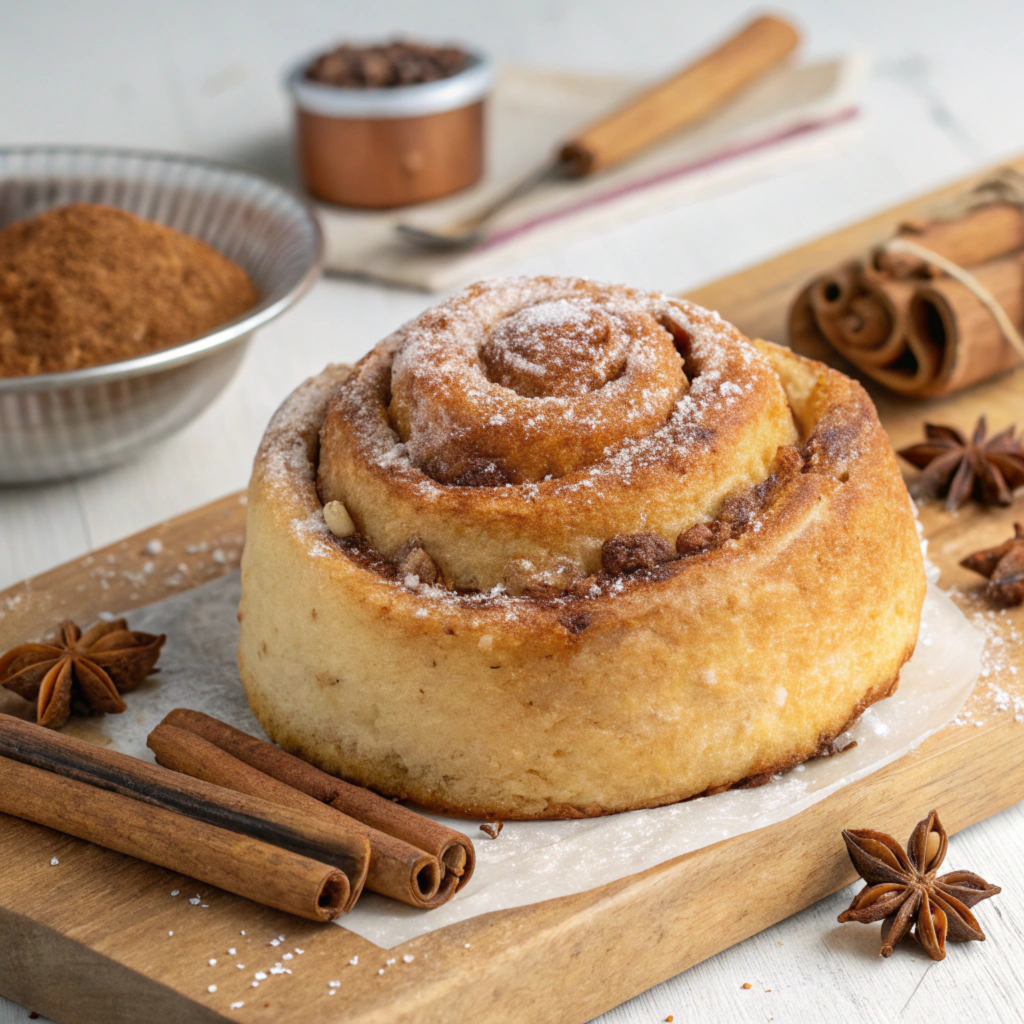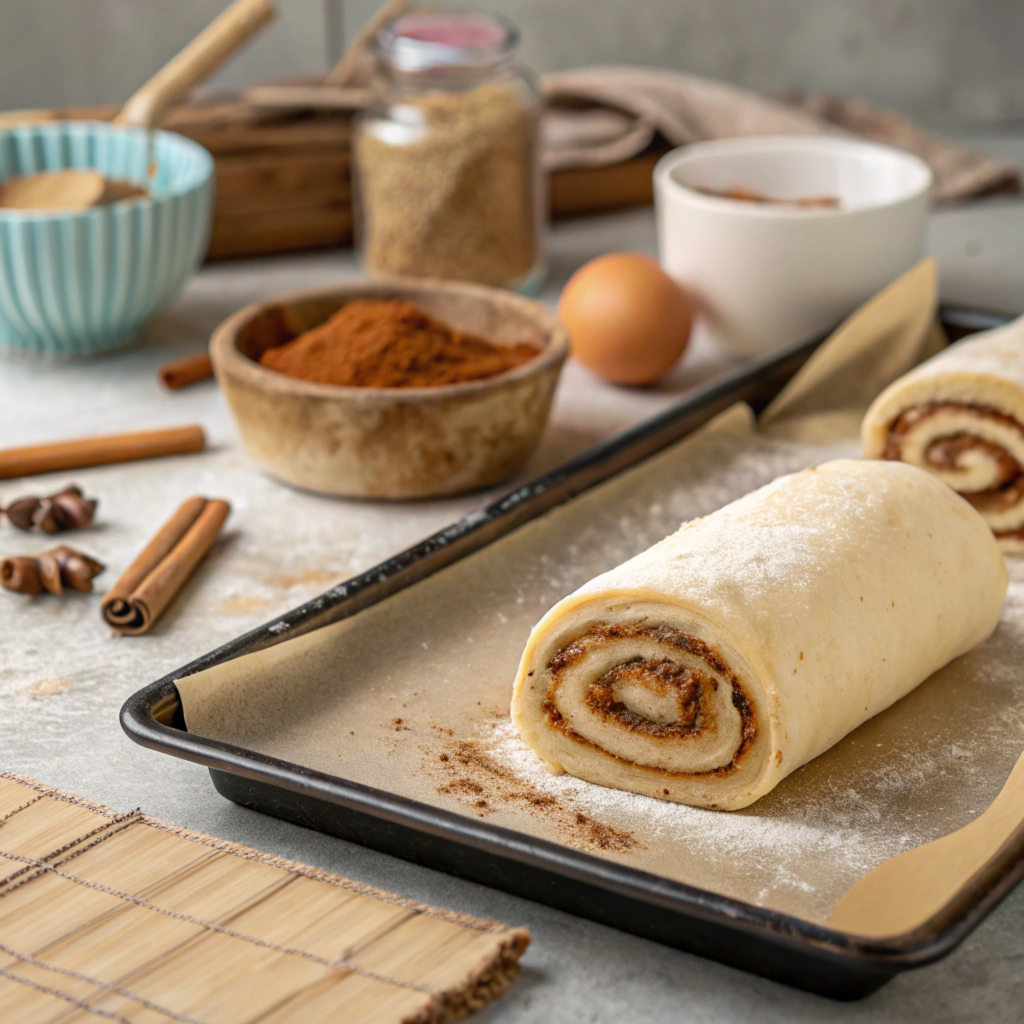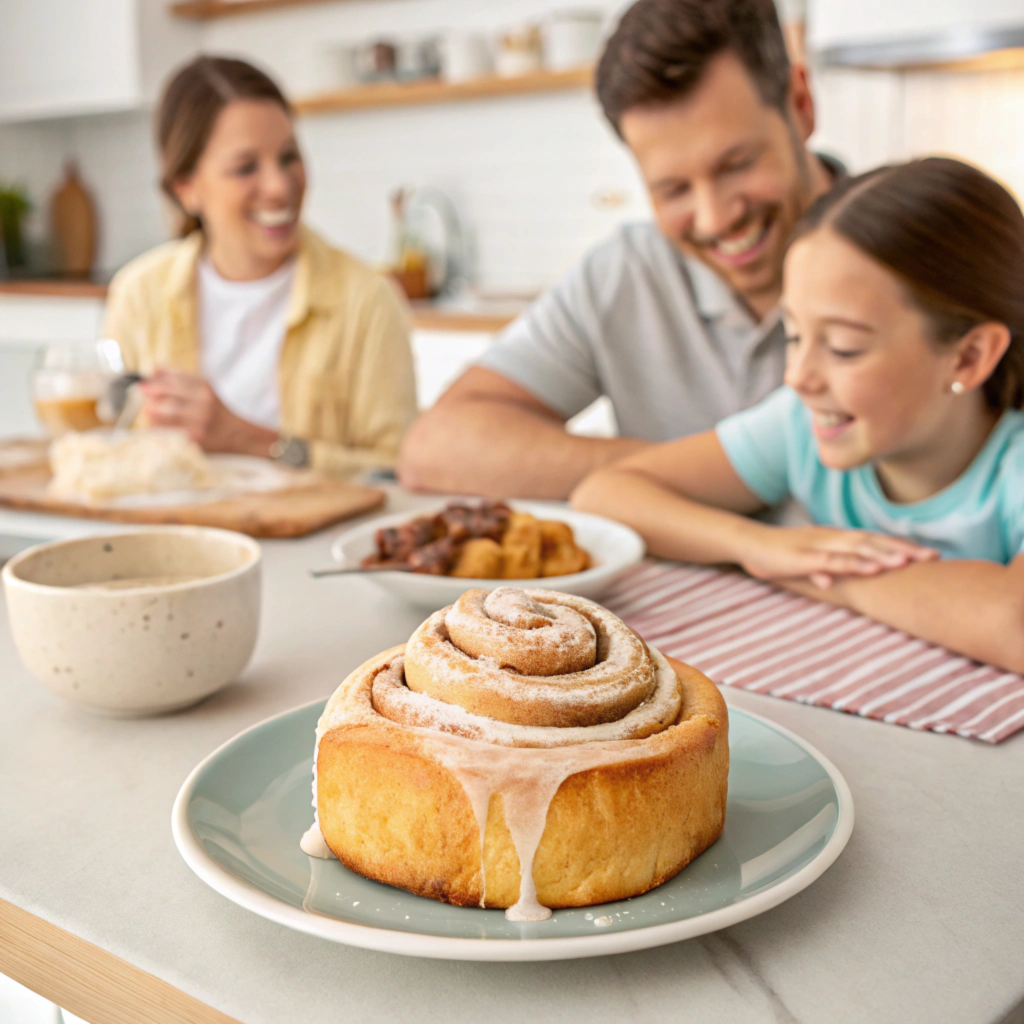
Introduction
A cinnamon roll is a sweet, spiraled pastry filled with cinnamon-sugar and often topped with a luscious frosting or glaze. This beloved treat is enjoyed worldwide, known for its soft, fluffy dough and warm, spiced flavor. Whether served as a breakfast indulgence, a dessert, or a snack, cinnamon rolls offer the perfect balance of sweetness and comfort, making them irresistible to pastry lovers everywhere.
Why Are Cinnamon Rolls So Popular?
The popularity of cinnamon rolls stems from their universal appeal and versatility. Their combination of rich, buttery dough and sweet, spiced filling makes them a comfort food favorite across different cultures. People love their aroma while baking—a warm, inviting scent that instantly creates a cozy atmosphere.
Cinnamon rolls are enjoyed during breakfast, brunch, or afternoon tea. They are commonly found at bakeries, cafes, and even holiday gatherings. Their sweet and spiced flavor profile pairs well with coffee, tea, or hot chocolate, enhancing their appeal as a satisfying treat.
Additionally, cinnamon rolls are highly customizable. From adding nuts and dried fruits to experimenting with different glazes like cream cheese frosting or vanilla icing, bakers can easily adjust recipes to suit personal preferences.

History and Origin of Cinnamon Rolls
The history of cinnamon rolls dates back hundreds of years, with roots in European baking traditions. Historians trace the origin of modern cinnamon rolls to Sweden, where the “kanelbulle” (cinnamon bun) emerged in the 1920s. Swedish cinnamon buns typically feature cardamom-spiced dough topped with pearl sugar rather than frosting.
Meanwhile, in Germany, sweet rolls known as “schnecken” (meaning “snail” for their coiled shape) became popular for their similar spiral design. As European settlers migrated to the United States, they brought cinnamon roll recipes with them, leading to the American-style cinnamon rolls famous today.
The U.S. popularized cinnamon rolls in the 20th century, particularly in the Midwest. Iconic bakeries and brands such as Cinnabon helped spread their fame, turning cinnamon rolls into a globally recognized treat.
Occasions to Enjoy Cinnamon Rolls
Cinnamon rolls are versatile enough to be enjoyed on various occasions. Here are some common times when these delicious treats take center stage:
1. Breakfast or Brunch:
Cinnamon rolls are a breakfast staple, often paired with coffee, tea, or fresh fruit. Their sweet, filling nature makes them a satisfying start to the day.
2. Holiday Celebrations:
Many families bake cinnamon rolls during holidays like Christmas and Easter. They make for a festive breakfast or brunch centerpiece.
3. Special Gatherings and Parties:
Cinnamon rolls are popular at brunch gatherings, baby showers, and family get-togethers. Mini cinnamon rolls are especially convenient for serving at large events.
4. Weekend Baking Projects:
Home bakers often choose cinnamon rolls for weekend baking projects. Making them from scratch can be a fun, rewarding experience, filling the home with a delightful aroma.
5. Dessert or Afternoon Treat:
Though primarily known as a breakfast item, cinnamon rolls also work well as a dessert or afternoon snack. Warm, gooey rolls topped with cream cheese frosting make for an indulgent treat any time of day.
What Is a Cinnamon Roll?
Introduction
A cinnamon roll is a sweet, spiraled pastry filled with cinnamon-sugar and often topped with a luscious frosting or glaze. This beloved treat is enjoyed worldwide, known for its soft, fluffy dough and warm, spiced flavor. Whether served as a breakfast indulgence, a dessert, or a snack, cinnamon rolls offer the perfect balance of sweetness and comfort, making them irresistible to pastry lovers everywhere.
Why Are Cinnamon Rolls So Popular?
The popularity of cinnamon rolls stems from their universal appeal and versatility. Their combination of rich, buttery dough and sweet, spiced filling makes them a comfort food favorite across different cultures. People love their aroma while baking—a warm, inviting scent that instantly creates a cozy atmosphere.
Cinnamon rolls are enjoyed during breakfast, brunch, or afternoon tea. They are commonly found at bakeries, cafes, and even holiday gatherings. Their sweet and spiced flavor profile pairs well with coffee, tea, or hot chocolate, enhancing their appeal as a satisfying treat.
Additionally, cinnamon rolls are highly customizable. From adding nuts and dried fruits to experimenting with different glazes like cream cheese frosting or vanilla icing, bakers can easily adjust recipes to suit personal preferences.
History and Origin of Cinnamon Rolls
The history of cinnamon rolls dates back hundreds of years, with roots in European baking traditions. Historians trace the origin of modern cinnamon rolls to Sweden, where the “kanelbulle” (cinnamon bun) emerged in the 1920s. Swedish cinnamon buns typically feature cardamom-spiced dough topped with pearl sugar rather than frosting.
Meanwhile, in Germany, sweet rolls known as “schnecken” (meaning “snail” for their coiled shape) became popular for their similar spiral design. As European settlers migrated to the United States, they brought cinnamon roll recipes with them, leading to the American-style cinnamon rolls famous today.
The U.S. popularized cinnamon rolls in the 20th century, particularly in the Midwest. Iconic bakeries and brands such as Cinnabon helped spread their fame, turning cinnamon rolls into a globally recognized treat.

Occasions to Enjoy Cinnamon Rolls
Cinnamon rolls are versatile enough to be enjoyed on various occasions. Here are some common times when these delicious treats take center stage:
1. Breakfast or Brunch:
Cinnamon rolls are a breakfast staple, often paired with coffee, tea, or fresh fruit. Their sweet, filling nature makes them a satisfying start to the day.
2. Holiday Celebrations:
Many families bake cinnamon rolls during holidays like Christmas and Easter. They make for a festive breakfast or brunch centerpiece.
3. Special Gatherings and Parties:
Cinnamon rolls are popular at brunch gatherings, baby showers, and family get-togethers. Mini cinnamon rolls are especially convenient for serving at large events.
4. Weekend Baking Projects:
Home bakers often choose cinnamon rolls for weekend baking projects. Making them from scratch can be a fun, rewarding experience, filling the home with a delightful aroma.
5. Dessert or Afternoon Treat:
Though primarily known as a breakfast item, cinnamon rolls also work well as a dessert or afternoon snack. Warm, gooey rolls topped with cream cheese frosting make for an indulgent treat any time of day
Creating perfect cinnamon rolls involves several essential steps that ensure the dough is light and fluffy, the filling is rich and spiced, and the rolls are topped with a decadent glaze. Here’s a detailed, step-by-step guide to making cinnamon rolls at home.
Step-by-Step Guide to Making Cinnamon Rolls
1. Preparing the Dough
The dough is the foundation of soft, fluffy cinnamon rolls. Properly preparing the dough ensures that the rolls rise well and bake evenly.
1.1. Activating the Yeast
- Warm the Milk: Heat whole milk to about 110°F (43°C).
- Add Yeast and Sugar: Combine warm milk, sugar, and active dry yeast. Stir gently and let it sit for 5-10 minutes until frothy.
Tip: If the mixture doesn’t foam, the yeast may be inactive or the milk may be too hot or cold. Start over for best results.
1.2. Mixing and Kneading the Dough
- Combine Ingredients: In a large bowl, mix flour, salt, eggs, melted butter, and the activated yeast mixture.
- Knead the Dough: Use a stand mixer with a dough hook or knead by hand for 8-10 minutes until the dough becomes soft, smooth, and slightly sticky.
- First Rise: Place the dough in a greased bowl, cover with a damp cloth, and let it rise for 1-2 hours until it doubles in size.
Tip: Letting the dough rise in a warm place ensures proper fermentation and fluffiness.
2. Creating the Filling
The filling is where the cinnamon rolls get their signature sweet and spiced flavor.
2.1. Mixing the Filling
- Ingredients: Mix softened butter, brown sugar, and ground cinnamon in a small bowl.
- Customize: Add vanilla extract, nutmeg, or chopped nuts for extra flavor.
Tip: Use room-temperature butter to ensure the filling spreads evenly and doesn’t tear the dough.
2.2. Spreading the Filling Evenly
- Roll Out the Dough: After the first rise, roll out the dough on a floured surface into a large rectangle about ¼-inch thick.
- Spread the Filling: Evenly spread the cinnamon-sugar mixture over the entire surface of the dough, ensuring full coverage.
Tip: Leave a small border around the edges to prevent the filling from spilling out when rolling.
3. Rolling and Shaping the Rolls
This step determines the signature swirl shape of cinnamon rolls.
3.1. Rolling the Dough Tightly
- Start from One Edge: Begin rolling the dough tightly from one long edge.
- Seal the Edge: Pinch the seam along the edge to seal the roll, ensuring the filling stays inside.
Tip: Roll as tightly as possible for well-defined swirls and evenly baked rolls.
3.2. Cutting Even Pieces
- Cut the Roll: Use a sharp knife or unflavored dental floss to cut the rolled dough into 12-15 even pieces.
- Arrange on a Pan: Place the rolls in a greased baking dish, leaving space between them to allow for expansion during the second rise.
Tip: For even baking, make sure the rolls are uniform in size.
4. Baking the Rolls
This step transforms the dough into golden-brown, fluffy cinnamon rolls.
4.1. Preheating the Oven
- Preheat: Set the oven to 350°F (175°C).
- Second Rise: Let the cut rolls rise for 30-45 minutes until puffy and doubled in size.
4.2. Baking Until Golden Brown
- Bake: Place the rolls in the preheated oven and bake for 20-25 minutes, or until they turn golden brown.
- Check Doneness: The internal temperature should reach 190°F (88°C), and the tops should be firm but soft.
Tip: Avoid overbaking, as this can cause the rolls to dry out.
5. Adding the Topping
The topping adds the final layer of sweetness and creaminess to freshly baked cinnamon rolls.
5.1. Spreading Cream Cheese Frosting
- Ingredients: Mix softened cream cheese, powdered sugar, vanilla extract, and butter in a bowl until smooth.
- Spread While Warm: Apply the frosting while the rolls are still warm for a deliciously melted finish.
5.2. Drizzling a Glaze
- Make a Simple Glaze: Combine powdered sugar, milk, and vanilla extract to make a smooth glaze.
- Drizzle Generously: Use a spoon or piping bag to drizzle the glaze over the rolls.
Tip: Add a pinch of cinnamon or maple syrup to the glaze for extra flavor.
Popular Cinnamon Roll Variations
1. Classic Cinnamon Rolls
Classic cinnamon rolls feature soft, fluffy dough, cinnamon-sugar filling, and cream cheese frosting. These timeless treats are a staple at bakeries and coffee shops around the world.
Why They’re Popular:
- Their sweet, spiced flavor pairs perfectly with coffee or tea.
- The cream cheese frosting provides a rich, tangy finish.
- Ideal for breakfast, brunch, or dessert.
Occasion Tip: Serve classic cinnamon rolls warm for the ultimate comfort food experience.Cinnamon Roll
2. Mini Cinnamon Rolls
Mini cinnamon rolls are bite-sized versions of the classic recipe, making them perfect for parties, brunch buffets, and dessert platters. Despite their small size, they deliver the same irresistible flavor as their larger counterparts.
What Makes Them Special:
- Easy to grab and enjoy on the go.
- Great for serving at holiday gatherings or potlucks.
- Kid-friendly and ideal for snack-time treats.
Serving Tip: Arrange mini cinnamon rolls on a tiered tray for a stunning party centerpiece.Cinnamon Roll
3. Gluten-Free Cinnamon Rolls
Gluten-free cinnamon rolls cater to those with dietary restrictions, ensuring that everyone can enjoy this iconic treat. These rolls are typically made with almond flour, coconut flour, or a gluten-free flour blend.
Why They’re Loved:
- They provide the same soft texture and cinnamon flavor as regular rolls.
- Perfect for individuals with gluten intolerance or celiac disease.
- Often paired with dairy-free frosting for a fully allergen-friendly option.
Baking Tip: Use xanthan gum for better dough elasticity when making gluten-free cinnamon rolls.
4. Vegan Cinnamon Rolls
Vegan cinnamon rolls are made without eggs, dairy, or animal products, using plant-based ingredients that still deliver rich flavor and a soft texture.
Key Ingredients:
- Plant-based butter or coconut oil replaces regular butter.
- Almond milk or oat milk substitutes for dairy milk.
- Flaxseed or chia seeds are used as egg substitutes.
Health Tip: Use natural sweeteners like maple syrup or coconut sugar for a healthier twist.
5. Savory Cinnamon Rolls
Savory cinnamon rolls put a unique twist on the classic recipe by swapping sweet fillings for cheeses, herbs, and spices. These rolls are perfect for brunch spreads, appetizers, or even as a savory side dish.
Popular Savory Fillings:
- Cheese and Garlic: A combination of mozzarella, cheddar, or Parmesan cheese with garlic butter.
- Spinach and Feta: A Mediterranean-inspired filling with crumbled feta cheese and fresh spinach.
- Herb and Cream Cheese: Made with fresh herbs like rosemary, thyme, and chives.
Serving Idea: Pair savory cinnamon rolls with a fresh salad or soup for a balanced meal.
6. No-Yeast Cinnamon Rolls
No-yeast cinnamon rolls are quick and easy to make, skipping the long rise time required by traditional recipes. These rolls use baking powder or baking soda for leavening, producing a soft, biscuit-like texture.
Why They’re Convenient:
- Perfect for last-minute baking projects.
- Great for beginner bakers or those short on time.
- Ready to enjoy in under an hour.Cinnamon Roll
Baking Tip: Use buttermilk or Greek yogurt for a tender, flavorful dough.
7. Caramel Pecan Cinnamon Rolls
Caramel pecan cinnamon rolls add a sticky-sweet twist with a caramel glaze and toasted pecans. These indulgent treats are perfect for special occasions and holiday breakfasts.
What Makes Them Unique:
- The caramel glaze creates a gooey, melt-in-your-mouth texture.
- Toasted pecans add crunch and a nutty, buttery flavor.
- They are often served as an upside-down roll, with the caramel topping baked at the bottom and flipped after baking.
Presentation Tip: Sprinkle extra pecans on top for added crunch and visual appeal.
8. Pumpkin Spice Cinnamon Rolls
Pumpkin spice cinnamon rolls combine warm fall spices like cinnamon, nutmeg, ginger, and cloves with pumpkin purée for a seasonal twist. They’re especially popular during autumn and holiday gatherings.
Why They’re a Fall Favorite:
- The pumpkin purée keeps the dough moist and flavorful.
- The spice blend creates a comforting, cozy aroma while baking.
- A maple or cream cheese glaze adds the perfect finishing touch.
Fall Tip: Serve with a pumpkin spice latte for the ultimate fall-themed treat.Cinnamon Roll
9. Nutella-Stuffed Cinnamon Rolls
Nutella-stuffed cinnamon rolls offer a decadent upgrade with chocolate-hazelnut filling. These rich, indulgent rolls are perfect for dessert or special brunches.
Why They’re a Hit:
- Nutella melts into a creamy, chocolatey center.
- They pair well with fresh berries or whipped cream.
- They are an instant favorite among chocolate lovers.
Serving Suggestion: Drizzle extra Nutella on top for a double dose of chocolate goodness.
10. Apple-Cinnamon Rolls
Apple-cinnamon rolls combine caramelized apples with cinnamon sugar, creating a warm, fruity filling that feels like autumn in every bite.
Why They’re Delicious:
- Fresh apples add a natural sweetness and juicy texture.
- Cinnamon enhances the fruit’s warm, spiced flavor.
- They’re perfect for holiday breakfasts and family brunches.
Baking Tip: Use tart apples like Granny Smith for a balanced flavor profile.
Final Thoughts
The variety of cinnamon rolls available ensures that everyone can enjoy this iconic treat, regardless of dietary preferences or flavor preferences. From classic frosted rolls to creative twists like pumpkin spice and savory herb-filled versions, cinnamon rolls continue to be versatile, delicious, and universally loved.
1 thought on “What Is a Cinnamon Roll?”